Hydroclimatology of the Chitral River in the Indus Basin under Changing Climate
Abstract
:1. Introduction
2. Materials and Methods
2.1. Study Area
2.2. Datasets
2.2.1. Climate Datasets
2.2.2. Future Climate Projection
2.3. Methodolgy
2.3.1. Bias Correction
2.3.2. SWAT Hydrological Model
2.3.3. Pre-Modeling Setup
3. Results and Discussion
3.1. Calibration and Validation Results
3.2. GCM Selection
3.3. Hydroclimatological Projections
3.3.1. Temperature
3.3.2. Precipitation
3.3.3. Water Availability
3.3.4. Flow Regime
3.3.5. High and Low Flows
4. Conclusions
Supplementary Materials
Author Contributions
Funding
Data Availability Statement
Conflicts of Interest
References
- Sabine, C. Ask the Experts: The IPCC Fifth Assessment Report. Carbon Manag. 2014, 5, 17–25. [Google Scholar] [CrossRef]
- Lutz, A.; Immerzeel, W.W.; Kraaijenbrink, P.; Shrestha, A.; Bierkens, M.F.P. Climate Change Impacts on the Upper Indus Hydrology: Sources, Shifts and Extremes. PLoS ONE 2016, 11, e0165630. [Google Scholar] [CrossRef] [PubMed] [Green Version]
- Ul Hasson, S.; Saeed, F.; Böhner, J.; Schleussner, C.-F. Water Availability in Pakistan from Hindukush-Karakoram-Himalayan Watersheds at 1.5 °C and 2 °C Paris Agreement Targets. Adv. Water Resour. 2019, 131, 103365. [Google Scholar] [CrossRef]
- Hashmi, M.; Masood, A.; Mushtaq, H.; Bukhari, S.; Ahmad, B.; Tahir, A. Exploring Climate Change Impacts during the First Half of the 21st Century on Flow Regime of the Transboundary Kabul River in the Hindukush Region. J. Water Clim. Chang. 2019, 11, 1521–1538. [Google Scholar] [CrossRef]
- Azmat, M.; Wahab, A.; Huggel, C.; Qamar, M.; Hussain, E.; Ahmad, S.; Waheed, A. Climatic and Hydrological Projections to Changing Climate under CORDEX-South Asia Experiments over the Karakoram-Hindukush-Himalayan Water Towers. Sci. Total Environ. 2019, 703, 135010. [Google Scholar] [CrossRef]
- Aryal, J.; Jat, M.; Sapkota, T.; Khatri-Chhetri, A.; Kassie, M.; Rahut, D.B.; Maharjan, S. Adoption of Multiple Climate-Smart Agricultural Practices in the Gangetic Plains of Bihar, India. Int. J. Clim. Chang. Strateg. Manag. 2018, 10, 407–427. [Google Scholar] [CrossRef]
- Dahri, Z.H.; Moors, E.; Ludwig, F.; Ahmad, S.; Khan, A.; Ali, I.; Kabat, P. Adjustment of Measurement Errors to Reconcile Precipitation Distribution in the High-Altitude Indus Basin. Int. J. Clim. 2018, 38, 3842–3860. [Google Scholar] [CrossRef]
- Immerzeel, W.W.; Pellicciotti, F.; Bierkens, M.F.P. Rising River Flows throughout the Twenty-First Century in Two Himalayan Glacierized Watersheds. Nat. Geosci. 2013, 6, 742–745. [Google Scholar] [CrossRef]
- Immerzeel, W.W.; Wanders, N.; Lutz, A.; Shea, J.M.; Bierkens, M.F.P. Reconciling High-Altitude Precipitation in the Upper Indus Basin with Glacier Mass Balances and Runoff. Hydrol. Earth Syst. Sci. 2015, 19, 4673–4687. [Google Scholar] [CrossRef] [Green Version]
- Bokhari, S.; Ahmad, B.; Ali, J.; Ahmad, S.; Mushtaq, H.; Rasul, G. Future Climate Change Projections of the Kabul River Basin Using a Multi-Model Ensemble of High-Resolution Statistically Downscaled Data. Earth Syst. Environ. 2018, 2, 477–497. [Google Scholar] [CrossRef]
- Lutz, A.; Immerzeel, W.W.; Shrestha, A.; Bierkens, M.F.P. Consistent Increase in High Asia’s Runoff Due to Increasing Glacier Melt and Precipitation. Nat. Clim. Chang. 2014, 4, 587–592. [Google Scholar] [CrossRef] [Green Version]
- Nizami, A.; Ali, J.; Zulfiqar, M. Climate Change, Hydro-Meteorological Hazards and Adaptation for Sustainable Livelihood in Chitral Pakistan. Sarhad J. Agric. 2019, 35, 432–441. [Google Scholar] [CrossRef]
- Ahmed, K.; Iqbal, Z.; Khan, N.; Rasheed, B.; Nawaz, N.; Malik, I.; Noor, M. Quantitative Assessment of Precipitation Changes under CMIP5 RCP Scenarios over the Northern Sub-Himalayan Region of Pakistan. Environ. Dev. Sustain. 2020, 22, 7831–7845. [Google Scholar] [CrossRef]
- Ahmad, S.; Israr, M.; Liu, S.; Hayat, H.; Gul, J.; Wajid, S.; Ashraf, M.; Baig, S.; Tahir, A.; Gul, J. Spatio-Temporal Trends in Snow Extent and Their Linkage to Hydro-Climatological and Topographical Factors in the Chitral River Basin (Hindukush, Pakistan). Geocarto Int. 2018, 35, 711–734. [Google Scholar] [CrossRef]
- Palazzi, E.; Hardenberg, J.; Provenzale, A. Precipitation in the Hindu-Kush Karakoram Himalaya: Observations and Future Scenarios. J. Geophys. Res. Atmos. 2013, 118, 85–100. [Google Scholar] [CrossRef]
- Baudouin, J.-P.; Herzog, M.; Petrie, C. Cross-Validating Precipitation Datasets in the Indus River Basin. Hydrol. Earth Syst. Sci. 2019, 24, 427–450. [Google Scholar] [CrossRef] [Green Version]
- Yuan, F.; Zhang, L.; Win, K.W.W.; Ren, L.; Zhao, C.; Zhu, Y.; Jiang, S.; Liu, Y. Assessment of GPM and TRMM Multi-Satellite Precipitation Products in Streamflow Simulations in a Data-Sparse Mountainous Watershed in Myanmar. Remote Sens. 2017, 9, 302. [Google Scholar] [CrossRef] [Green Version]
- Iqbal, M.; Athar, H. Validation of Satellite Based Precipitation over Diverse Topography of Pakistan. Atmos. Res. 2017, 201, 247–260. [Google Scholar] [CrossRef]
- Rana, S.; Mcgregor, J.; Renwick, J. Precipitation Seasonality over the Indian Subcontinent: An Evaluation of Gauge, Reanalyses and Satellite Retrievals. J. Hydrometeorol. 2014, 16, 631–651. [Google Scholar] [CrossRef]
- Kishore, P.; Jyothi, S.; Basha, G.; Rao, S.; Rajeevan, M.; Velicogna, I.; Sutterley, T. Precipitation Climatology over India: Validation with Observations and Reanalysis Datasets and Spatial Trends. Clim. Dyn. 2015, 46, 541–556. [Google Scholar] [CrossRef] [Green Version]
- Pelosi, A.; Terribile, F.; D’Urso, G.; Chirico, G.B. Comparison of ERA5-Land and UERRA MESCAN-SURFEX Reanalysis Data with Spatially Interpolated Weather Observations for the Regional Assessment of Reference Evapotranspiration. Water 2020, 12, 1669. [Google Scholar] [CrossRef]
- Bromwich, D.; Wilson, A.; Bai, L.; Moore, G.W.K.; Bauer, P. A Comparison of the Regional Arctic System Reanalysis and the Global ERA-Interim Reanalysis for the Arctic. Q. J. R. Meteorol. Soc. 2015, 142, 644–658. [Google Scholar] [CrossRef] [Green Version]
- Hersbach, H.; De Rosnay, P.; Bell, B.; Schepers, D.; Simmons, A.; Soci, C.; Abdalla, S.; Alonso-Balmaseda, M.; Balsamo, G.; Bechtold, P.; et al. Operational Global Reanalysis: Progress, Future Directions and Synergies with NWP; ERA Report Series No. 27; ECMWF: Reading, UK, 2018. [Google Scholar] [CrossRef]
- Nesterova, N.; Makarieva, O.; Post, D.A. Parameterizing a Hydrological Model Using a Short-term Observational Dataset to Study Runoff Generation Processes and Reproduce Recent Trends in Streamflow at a Remote Mountainous Permafrost Basin. Hydrol. Process. 2021, 35, e14278. [Google Scholar] [CrossRef]
- Dahri, Z.H.; Ludwig, F.; Moors, E.; Ahmad, S.; Ahmad, B.; Ahmad, S.; Riaz, M.; Kabat, P. Climate Change and Hydrological Regime of the High-Altitude Indus Basin under Extreme Climate Scenarios. Sci. Total Environ. 2021, 768, 144467. [Google Scholar] [CrossRef]
- Ficklin, D.; Abatzoglou, J.; Robeson, S.; Dufficy, A. The Influence of Climate Model Biases on Projections of Aridity and Drought. J. Clim. 2015, 29, 1269–1285. [Google Scholar] [CrossRef]
- Lutz, A.; ter Maat, H.; Biemans, H.; Shrestha, A.; Wester, P.; Immerzeel, W.W. Selecting Representative Climate Models for Climate Change Impact Studies: An Advanced Envelope-Based Selection Approach. Int. J. Climatol. 2016, 36, 3988–4005. [Google Scholar] [CrossRef] [Green Version]
- Dahri, Z.H.; Ludwig, F.; Moors, E.; Ahmad, B.; Khan, A.; Kabat, P. An Appraisal of Precipitation Distribution in the High-Altitude Catchments of the Indus Basin. Sci. Total Environ. 2016, 548–549, 289–306. [Google Scholar] [CrossRef] [Green Version]
- Hersbach, H.; Bell, B.; Berrisford, P.; Hirahara, S.; Horányi, A.; Muñoz-Sabater, J.; Nicolas, J.; Peubey, C.; Radu, R.; Schepers, D.; et al. The ERA5 Global Reanalysis. Q. J. R. Meteorol. Soc. 2020, 146, 1999–2049. [Google Scholar] [CrossRef]
- ERA5-Land: Data Documentation. Available online: https://confluence.ecmwf.int/display/CKB/ERA5-Land%3A+data+documentation (accessed on 1 October 2021).
- Copernicus Climate Change Service. ERA5-Land Hourly Data from 2001 to Present ECMWF. Available online: https://cds.climate.copernicus.eu/doi/10.24381/cds.e2161bac (accessed on 1 October 2021).
- Shrestha, M.; Acharya, S.; Shrestha, P. Bias Correction of Climate Models for Hydrological Modeling—Are Simple Methods Still Useful? Meteorol. Appl. 2017, 24, 531–539. [Google Scholar] [CrossRef] [Green Version]
- Teutschbein, C.; Seibert, J. Bias Correction of Regional Climate Model Simulations for Hydrological Climate-Change Impact Studies: Review and Evaluation of Different Methods. J. Hydrol. 2012, 456–457, 12–29. [Google Scholar] [CrossRef]
- Lenderink, G.; van Ulden, A.; van den Hurk, B.; Keller, F. A Study on Combining Global and Regional Climate Model Results for Generating Climate Scenarios of Temperature and Precipitation for The Netherlands. Clim. Dyn. 2007, 29, 157–176. [Google Scholar] [CrossRef] [Green Version]
- Arnold, J.; Srinivasan, R.; Muttiah, R.; Williams, J.R. Large Area Hydrologic Modeling and Assessment Part I: Model Development. JAWRA J. Am. Water Resour. Assoc. 1998, 34, 73–89. [Google Scholar] [CrossRef]
- Gassman, P.; Sadeghi, A.; Srinivasan, R. Applications of the SWAT Model Special Section: Overview and Insights. J. Environ. Qual. 2014, 43, 1–8. [Google Scholar] [CrossRef] [PubMed]
- Gassman, P.; Reyes, M.; Green, C.; Arnold, J. Soil and Water Assessment Tool: Historical Development, Applications, and Future Research Directions. Trans. ASABE 2007, 50, 1211–1250. [Google Scholar] [CrossRef] [Green Version]
- Shrestha, S.; Shrestha, M.; Shrestha, P. Evaluation of the SWAT Model Performance for Simulating River Discharge in the Himalayan and Tropical Basins of Asia. Hydrol. Res. 2017, 49, 846–860. [Google Scholar] [CrossRef] [Green Version]
- Neitsch, S.; Arnold, J.; Kinry, J.R.; Williams, J.R. Soil and Water Assessment Tool Theoretical Documentation Version 2009; TR-406; Texas Water Resources Institute: College Station, TX, USA, 2011. [Google Scholar]
- FAO; IIASA; ISRIC; ISSCAS; JRC. Harmonized World Soil Database (Version 1.2); FAO: Rome, Italy; IIASA: Laxenburg, Austria, 2012. [Google Scholar]
- Yang, J.; Reichert, P.; Abbaspour, K.C.; Xia, J.; Yang, H. Comparing Uncertainty Analysis Techniques for a SWAT Application to the Chaohe Basin in China. J. Hydrol. 2008, 358, 1–23. [Google Scholar] [CrossRef]
- Ghoraba, S. Hydrological Modeling of the Simly Dam Watershed (Pakistan) Using GIS and SWAT Model. Alex. Eng. J. 2015, 54, 583–594. [Google Scholar] [CrossRef] [Green Version]
- Abbaspour, K.C. SWATCalibration and Uncertainty Programs; Eawag: Dubendorf, Switzerland, 2015; 100p. [Google Scholar]
- Abbaspour, K.C.; Ashraf Vaghefi, S.; Srinivasan, R. A Guideline for Successful Calibration and Uncertainty Analysis for Soil and Water Assessment: A Review of Papers from the 2016 International SWAT Conference. Water 2017, 10, 6. [Google Scholar] [CrossRef] [Green Version]
- Hosseini, S.H.; Hashemi, H.; Fakheri Fard, A.; Berndtsson, R. Areal Precipitation Coverage Ratio for Enhanced AI Modelling of Monthly Runoff: A New Satellite Data-Driven Scheme for Semi-Arid Mountainous Climate. Remote Sens. 2022, 14, 270. [Google Scholar] [CrossRef]
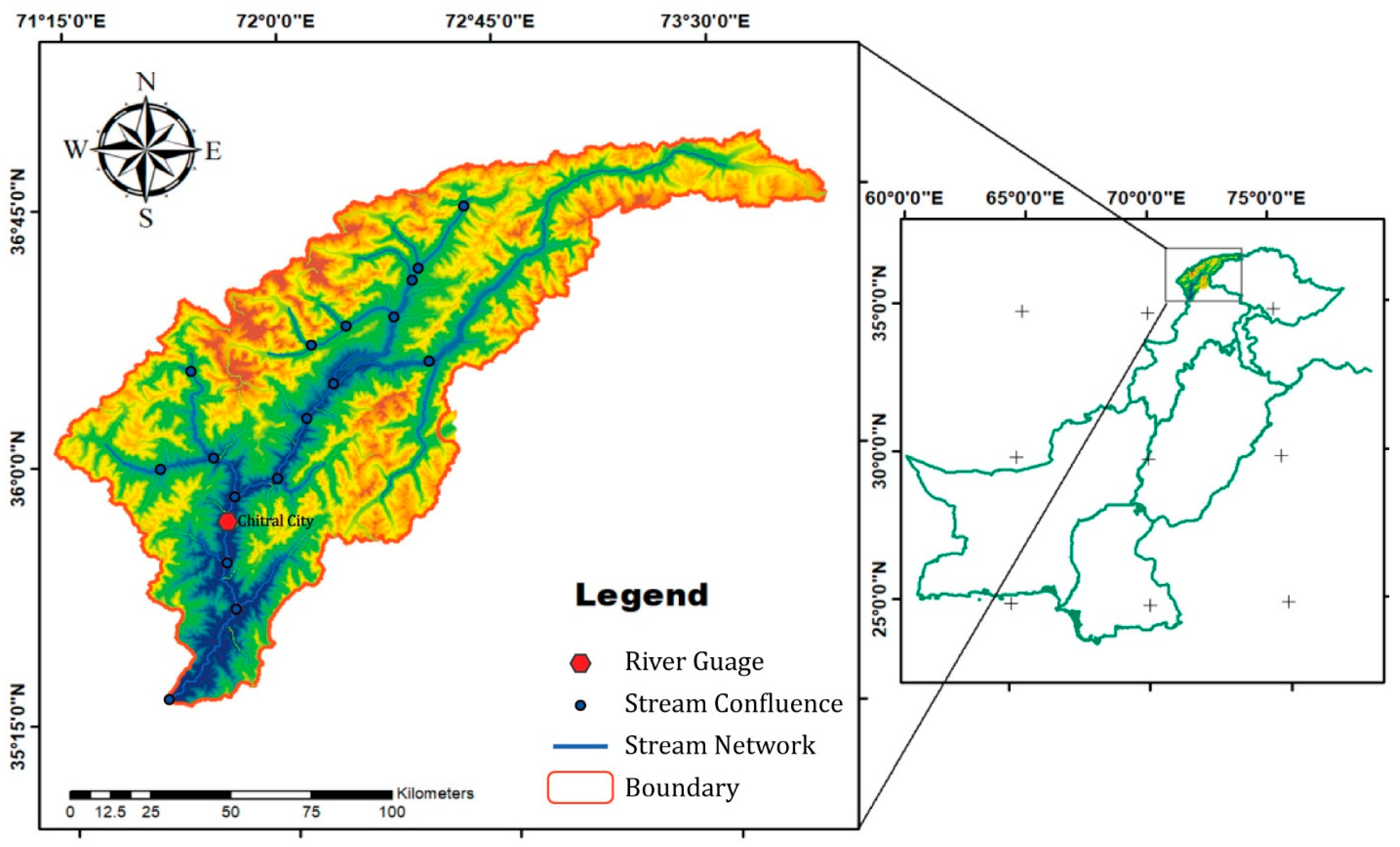
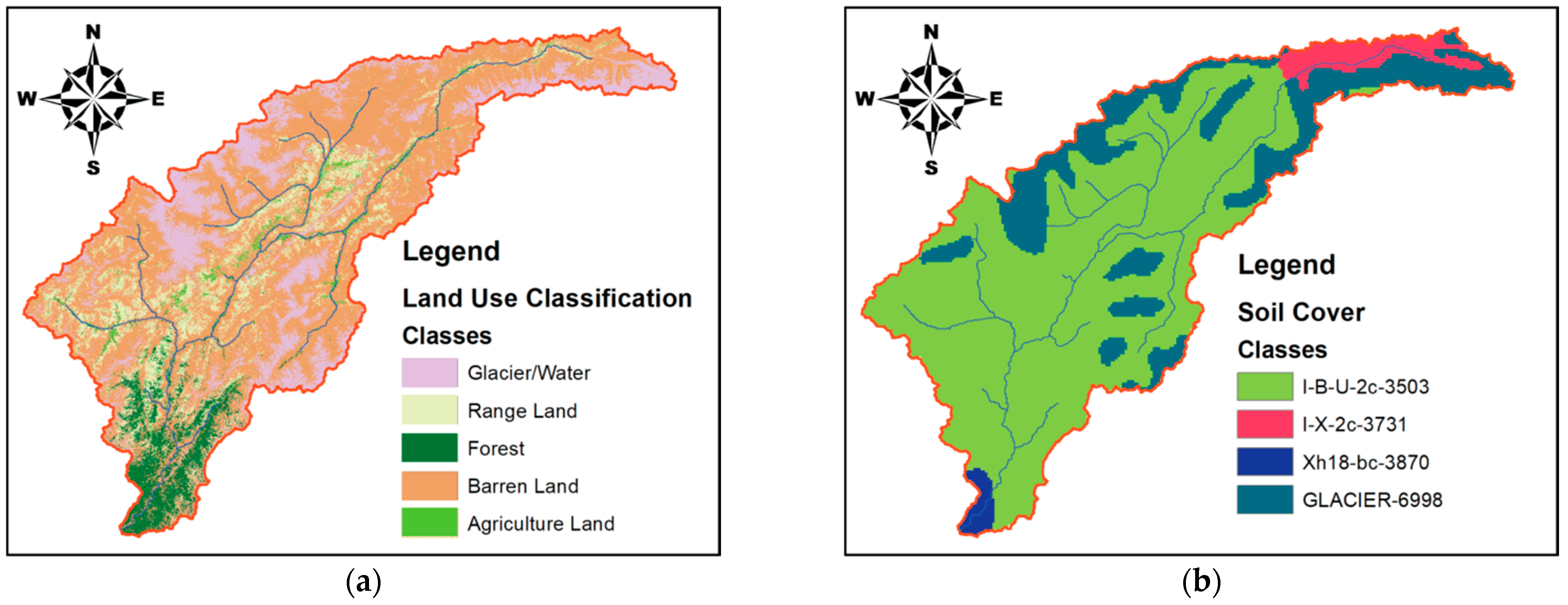

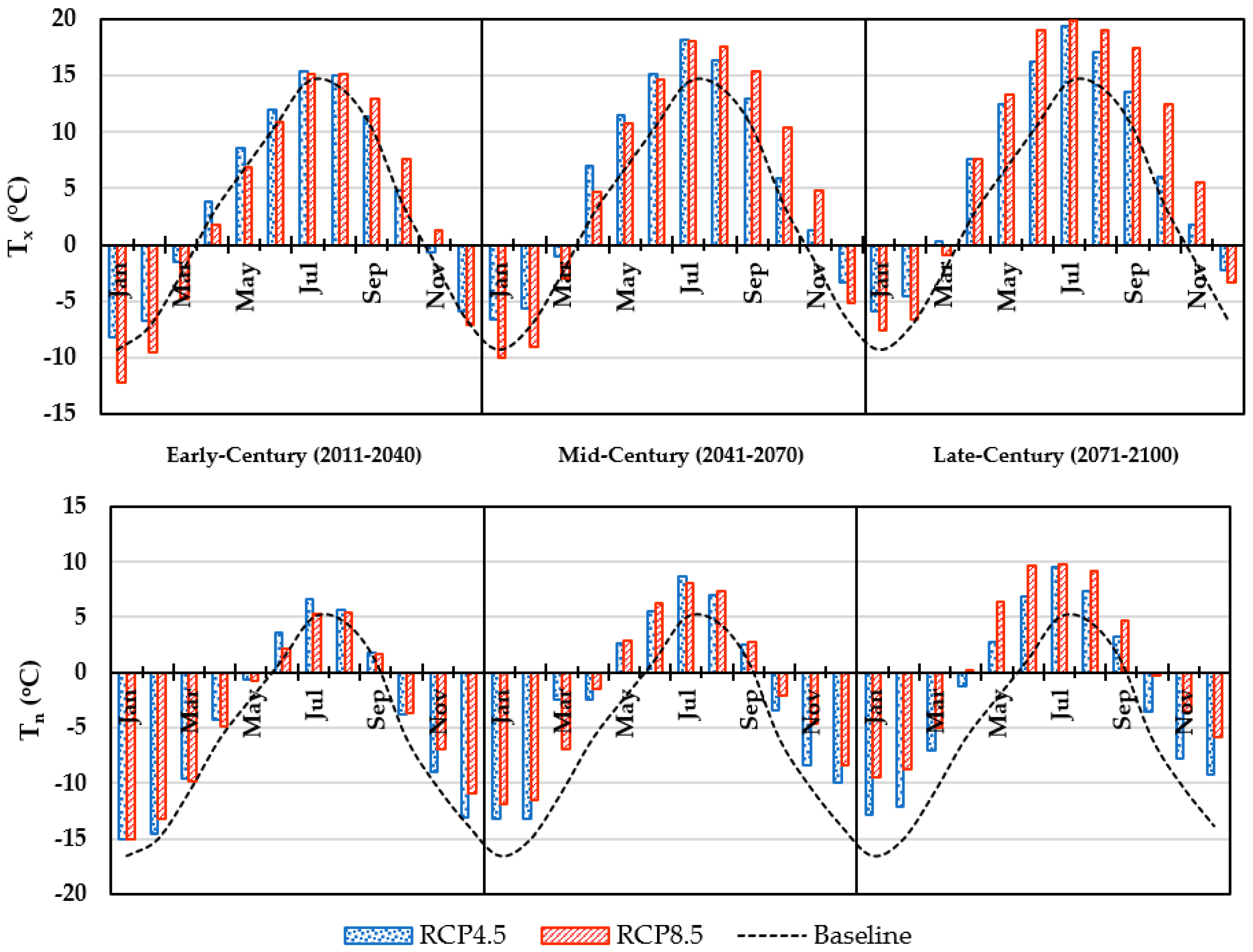
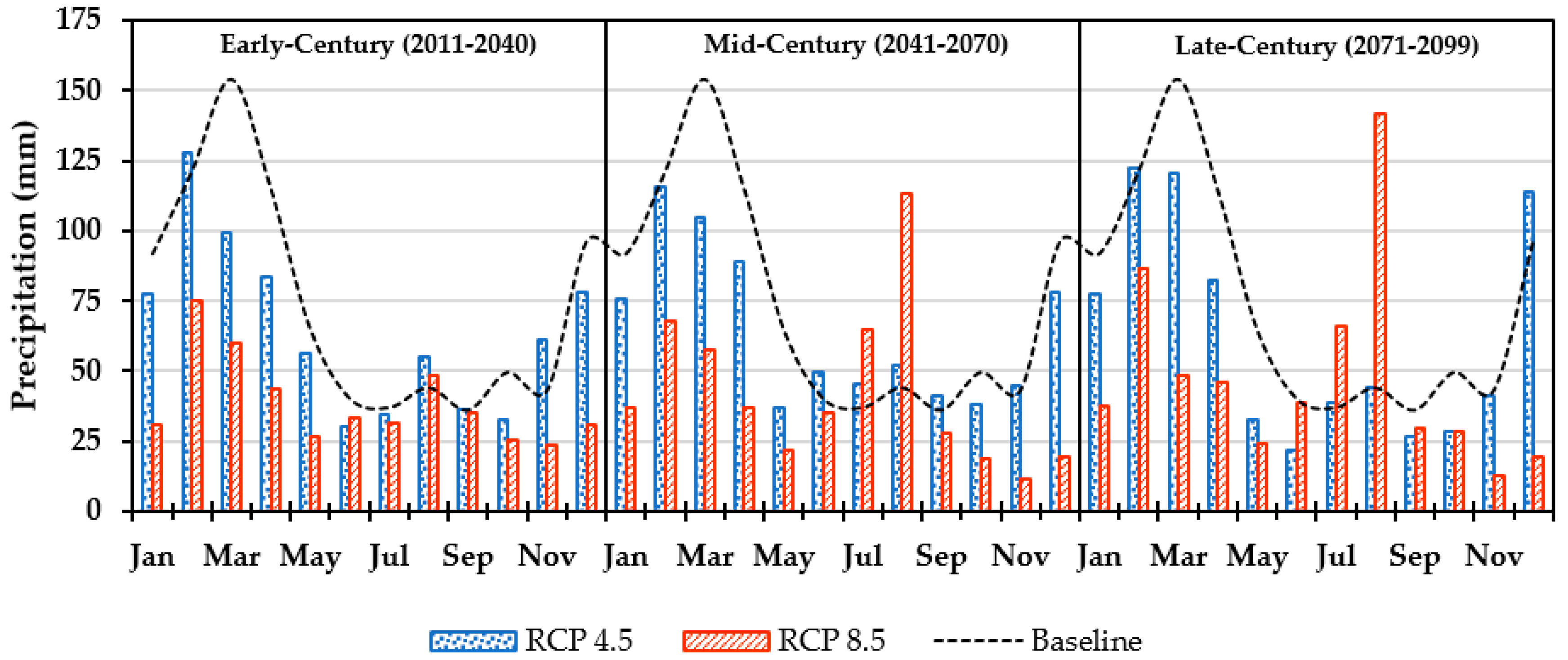

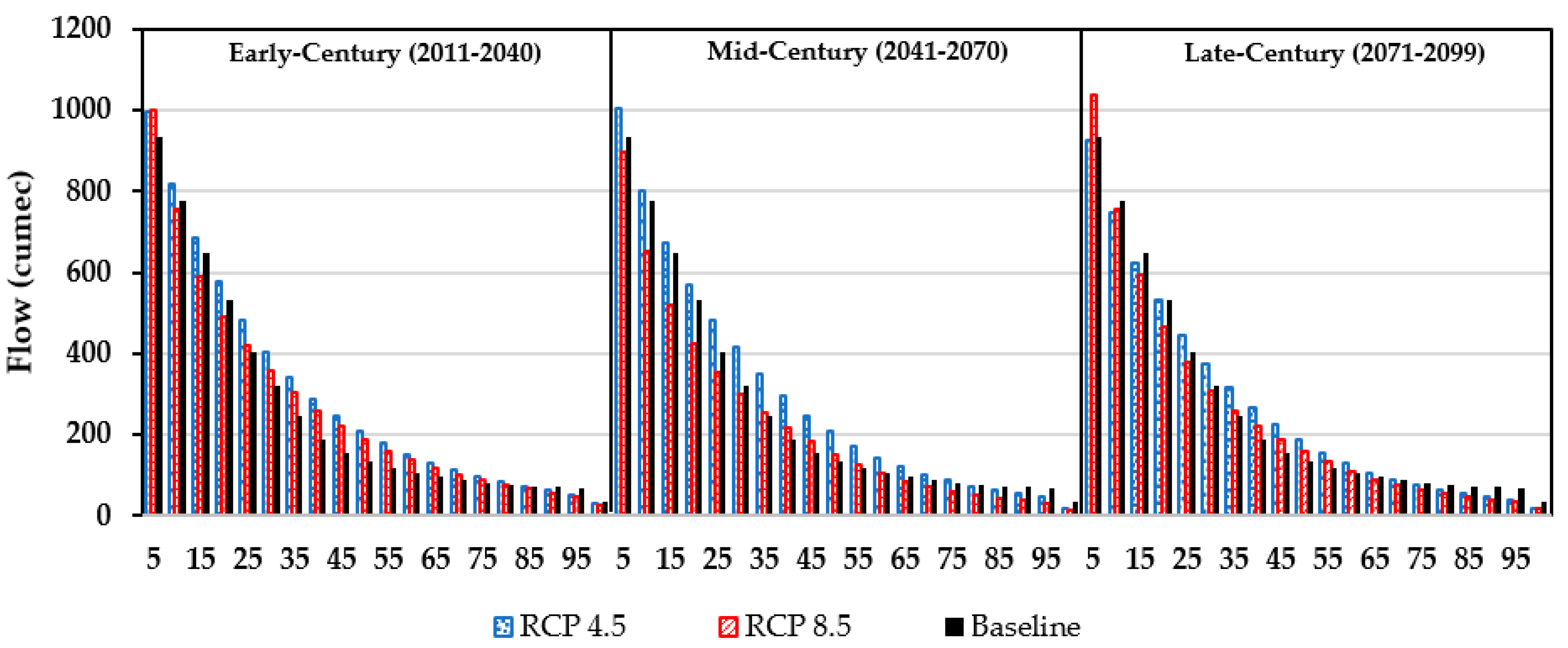
| Parameters | Description | |
|---|---|---|
| Hydrological Parameters | ||
| r__CN2.mgt | SCS runoff curve number | 0.00034 |
| v__ALPHA_BF.gw | Base flow alpha factor (days) | 0.99 |
| v__GW_DELAY.gw | Groundwater delay (days) | 85 |
| v__GWQMN.gw | Threshold in the shallow aquifer for return flow to occur (mm) | 89 |
| v__GW_REVAP.gw | Groundwater ‘‘revap” coefficient | 0.03 |
| v__SLSUBBSN.hru | Average slope length (m) | 55 |
| v__HRU_SLP.hru | Average slope steepness (m/m) | 0.03 |
| v__OV_N.hru | Manning’s “n” value for overland flow | 18 |
| Snow and Elevation Band Parameters | ||
| v__SFTMP.bsn | Snowfall temperature (°C) | 2.59 |
| v__SMTMP.bsn | Snow melt base temperature (°C) | −1.90 |
| v__SMFMX.bsn | Maximum snow melt rate during year of summer solstice (mm/°C-day) | 2.00 |
| v__TIMP.bsn | Snowpack temperature lag factor | 0.44 |
| v__TLAPS.sub | Temperature lapse rate (°C/Km) | −5.70 |
| v__PLAPS.sub | Precipitation lapse rate (mm/Km) | 301.25 |
| Statistical Indicator | Backward-Validation (1981–1995) | Calibration (1996–2005) | Forward-Validation (2006–2015) |
|---|---|---|---|
| Daily Basis | |||
| NSE | 0.79 | 0.84 | 0.78 |
| KGE | 0.82 | 0.91 | 0.85 |
| PBIAS (%) | −15.65 | 1.15 | −11.79 |
| RMSE | 136.61 | 117.87 | 129.91 |
| MAE | 88.51 | 78.10 | 85.89 |
| Monthly Basis | |||
| NSE | 0.87 | 0.90 | 0.86 |
| KGE | 0.82 | 0.92 | 0.85 |
| PBIAS (%) | −15.66 | 1.15 | −11.73 |
| RMSE | 99.87 | 85.80 | 96.20 |
| MAE | 68.46 | 58.34 | 62.61 |
| GCM | Final Rankings | |
|---|---|---|
| Precipitation | Temperature | |
| MIROC5_r1i1p1 | 1 | 1 |
| MIROC5_r2i1p1 | 2 | 3 |
| CMCC-CMS_r1i1p1 | 3 | 4 |
| MPI-ESM-LR_r1i1p1 | 4 | 2 |
| MPI-ESM-LR_r3i1p1 | 5 | 5 |
| Period | Tx (°C/Year) | Tn (°C/Year) | Tx (°C/Year) | Tn (°C/Year) |
|---|---|---|---|---|
| Baseline | 0.018 | 0.014 | 0.018 | 0.014 |
| RCP4.5 | RCP8.5 | |||
| Early Century | 0.082 | 0.079 | 0.072 | 0.097 |
| Midcentury | 0.053 | 0.042 | 0.081 | 0.074 |
| Late Century | −0.032 | −0.002 | 0.097 | 0.090 |
| Month | Jan | Feb | Mar | Apr | May | Jun | Jul | Aug | Sep | Oct | Nov | Dec |
|---|---|---|---|---|---|---|---|---|---|---|---|---|
| Baseline Tx | −9.24 | −7.45 | −2.48 | 2.77 | 6.98 | 10.88 | 14.38 | 14.2 | 10.39 | −1.28 | −6.13 | −6.13 |
| RCP4.5 | ||||||||||||
| Early Century | 0.82 | 0.39 | 1.27 | 1.56 | 1.72 | 1.82 | 1.07 | 0.82 | 0.88 | 1.45 | 1.00 | 0.42 |
| Midcentury | 2.35 | 1.69 | 2.62 | 3.96 | 4.55 | 4.27 | 3.51 | 2.20 | 2.35 | 2.50 | 2.76 | 2.75 |
| Late Century | 3.44 | 2.74 | 2.96 | 4.82 | 5.42 | 5.61 | 4.96 | 2.98 | 3.02 | 2.47 | 3.22 | 4.07 |
| Average | 2.20 | 1.61 | 2.28 | 3.45 | 3.90 | 3.90 | 3.18 | 2.00 | 2.08 | 2.14 | 2.32 | 2.41 |
| RCP8.5 | ||||||||||||
| Early Century | −2.91 | −2.26 | −2.19 | −0.96 | −0.16 | 0.28 | 0.62 | 1.05 | 2.43 | 4.07 | 2.76 | −0.87 |
| Midcentury | −0.70 | −1.77 | −0.39 | 1.97 | 3.68 | 4.01 | 3.54 | 3.56 | 4.93 | 6.90 | 6.25 | 1.12 |
| Late Century | 1.66 | 0.70 | 1.67 | 4.87 | 6.55 | 8.37 | 5.39 | 5.09 | 6.93 | 8.94 | 7.01 | 3.21 |
| Average | −0.65 | −1.11 | −0.30 | 1.96 | 3.36 | 4.22 | 3.18 | 3.24 | 4.77 | 6.64 | 5.34 | 1.15 |
| Baseline Tn | −16.5 | −15.26 | −10.75 | −6.02 | −2.14 | 1.17 | 4.95 | 4.69 | 0.83 | −10.27 | −13.5 | −13.5 |
| RCP4.5 | ||||||||||||
| Early Century | 0.69 | 0.40 | 1.54 | 1.76 | 1.70 | 2.28 | 1.40 | 1.12 | 0.78 | 1.87 | 1.29 | 0.49 |
| Midcentury | 2.26 | 1.93 | 3.28 | 3.64 | 4.17 | 4.40 | 3.44 | 2.34 | 1.62 | 2.53 | 2.08 | 3.33 |
| Late Century | 3.38 | 2.90 | 3.85 | 4.64 | 4.75 | 5.79 | 4.39 | 2.80 | 2.14 | 2.55 | 2.60 | 4.23 |
| Average | 2.11 | 1.74 | 2.89 | 3.35 | 3.54 | 4.15 | 3.08 | 2.09 | 1.52 | 2.31 | 1.99 | 2.68 |
| RCP8.5 | ||||||||||||
| Early Century | 1.15 | 1.81 | 1.02 | 1.05 | 1.24 | 1.08 | 0.15 | 0.86 | 0.61 | 2.42 | 3.38 | 2.50 |
| Midcentury | 6.82 | 6.36 | 6.01 | 6.16 | 8.55 | 8.53 | 4.73 | 4.59 | 3.71 | 5.72 | 6.84 | 7.55 |
| Late Century | 6.93 | 6.31 | 6.31 | 5.98 | 7.86 | 8.36 | 4.74 | 4.49 | 3.88 | 5.76 | 6.68 | 7.21 |
| Average | 4.97 | 4.83 | 4.45 | 4.40 | 5.88 | 5.99 | 3.21 | 3.31 | 2.74 | 4.64 | 5.64 | 5.75 |
| Month | Jan | Feb | Mar | Apr | May | Jun | Jul | Aug | Sep | Oct | Nov | Dec |
|---|---|---|---|---|---|---|---|---|---|---|---|---|
| Baseline (mm) | 91.89 | 121.48 | 154.22 | 114.96 | 64.89 | 40.15 | 36.91 | 43.97 | 35.98 | 49.56 | 42.95 | 96.22 |
| RCP4.5 | ||||||||||||
| Early Century | −15.5 | 5.0 | −35.6 | −27.0 | −13.0 | −24.0 | −5.6 | 24.9 | 1.6 | −33.4 | 42.3 | −18.5 |
| Midcentury | −17.5 | −4.7 | −32.0 | −22.4 | −43.4 | 23.1 | 23.3 | 18.9 | 13.9 | −23.3 | 4.8 | −19.0 |
| Late Century | −15.5 | 0.6 | −22.0 | −28.3 | −49.7 | −46.1 | 5.6 | 1.0 | −25.7 | −42.7 | −3.8 | 18.7 |
| Average | −16.15 | +0.29 | −29.88 | −25.92 | −35.33 | −15.67 | 7.74 | 14.95 | −3.42 | −33.13 | 14.45 | −6.29 |
| RCP8.5 | ||||||||||||
| Early Century | −66.7 | −38.3 | −60.9 | −61.8 | −58.9 | −17.2 | −14.0 | 10.4 | −1.6 | −48.9 | −44.3 | −67.6 |
| Midcentury | −59.8 | −44.3 | −62.5 | −67.6 | −66.8 | −13.1 | 75.9 | 158.3 | −22.5 | −62.5 | −73.8 | −79.7 |
| Late Century | −59.3 | −28.5 | −68.5 | −60.0 | −62.7 | −3.9 | 78.5 | 221.9 | −16.7 | −42.9 | −69.6 | −79.6 |
| Average | −61.89 | −37.03 | −63.98 | −63.13 | −62.78 | −11.41 | 46.8 | 130.20 | −13.60 | −51.41 | −62.59 | −75.64 |
| Month | Jan | Feb | Mar | Apr | May | Jun | Jul | Aug | Sep | Oct | Nov | Dec |
|---|---|---|---|---|---|---|---|---|---|---|---|---|
| Baseline (m3/s) | 77.64 | 68.78 | 68.47 | 94.52 | 187.31 | 496.51 | 846.61 | 767.12 | 380.32 | 171.21 | 114.91 | 89.6 |
| RCP4.5 | ||||||||||||
| Early Century | 19.83 | 3.60 | −10.10 | 51.04 | 88.63 | −9.77 | −2.00 | 3.84 | 17.13 | 63.64 | 66.40 | 47.38 |
| Midcentury | 1.08 | −15.18 | −18.32 | 300.76 | 218.30 | 13.53 | −15.41 | −18.70 | −0.14 | 34.93 | 36.52 | 23.81 |
| Late Century | −17.26 | −31.13 | −23.64 | 357.26 | 216.44 | 10.91 | −32.26 | −48.63 | −29.1 | 2.27 | 15.26 | −2.69 |
| Average | 1.22 | −14.24 | −17.35 | 236.36 | 174.46 | 4.89 | −16.56 | −21.16 | −4.04 | 33.61 | 39.39 | 22.83 |
| RCP8.5 | ||||||||||||
| Early Century | 9.65 | −7.66 | −9.32 | 13.77 | 54.46 | −23.09 | −21.14 | −18.88 | −0.84 | 44.09 | 44.01 | 32.80 |
| Midcentury | −28.42 | −41.00 | −38.45 | 243.09 | 121.26 | −23.85 | −45.52 | −21.50 | −22.14 | −1.21 | −1.93 | −12.60 |
| Late Century | −33.06 | −43.77 | −33.80 | 311.01 | 146.36 | −9.99 | −42.00 | −25.28 | −20.84 | −5.11 | −12.51 | −19.22 |
| Average | −17.28 | −30.81 | −27.19 | 189.29 | 107.36 | −18.98 | −36.22 | −21.89 | −14.61 | 12.59 | 9.86 | 0.33 |
Publisher’s Note: MDPI stays neutral with regard to jurisdictional claims in published maps and institutional affiliations. |
© 2022 by the authors. Licensee MDPI, Basel, Switzerland. This article is an open access article distributed under the terms and conditions of the Creative Commons Attribution (CC BY) license (https://creativecommons.org/licenses/by/4.0/).
Share and Cite
Syed, Z.; Ahmad, S.; Dahri, Z.H.; Azmat, M.; Shoaib, M.; Inam, A.; Qamar, M.U.; Hussain, S.Z.; Ahmad, S. Hydroclimatology of the Chitral River in the Indus Basin under Changing Climate. Atmosphere 2022, 13, 295. https://doi.org/10.3390/atmos13020295
Syed Z, Ahmad S, Dahri ZH, Azmat M, Shoaib M, Inam A, Qamar MU, Hussain SZ, Ahmad S. Hydroclimatology of the Chitral River in the Indus Basin under Changing Climate. Atmosphere. 2022; 13(2):295. https://doi.org/10.3390/atmos13020295
Chicago/Turabian StyleSyed, Zain, Shakil Ahmad, Zakir Hussain Dahri, Muhammad Azmat, Muhammad Shoaib, Azhar Inam, Muhammad Uzair Qamar, Syed Zia Hussain, and Sarfraz Ahmad. 2022. "Hydroclimatology of the Chitral River in the Indus Basin under Changing Climate" Atmosphere 13, no. 2: 295. https://doi.org/10.3390/atmos13020295






